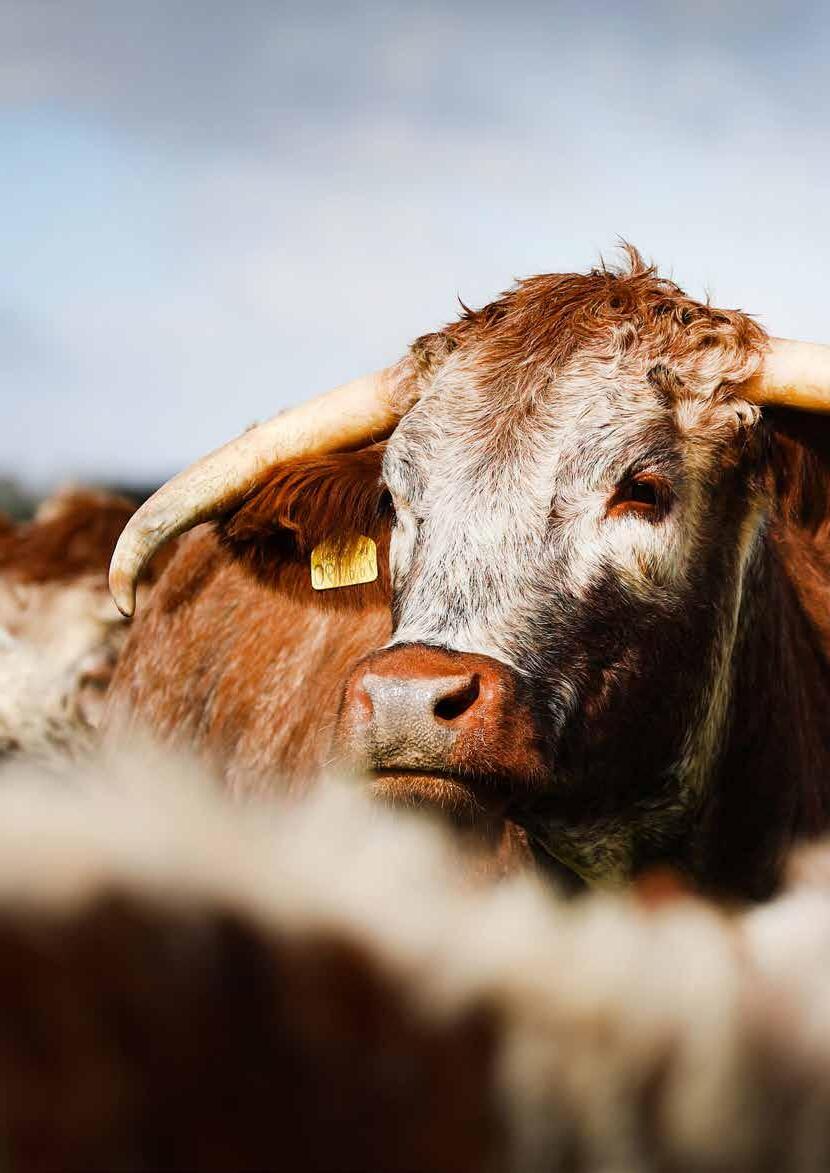THE

In the hot seat with Society trustees
Worcester sale peaks at 6000gns
Behind the scenes of the Three Bridges herd
Meet the new Society chairman, Clive Roads
Longhorns make a come back in the USA



In the hot seat with Society trustees
Worcester sale peaks at 6000gns
Behind the scenes of the Three Bridges herd
Meet the new Society chairman, Clive Roads
Longhorns make a come back in the USA

Welcome to the spring 2024 edition of The Longhorn, the Society’s magazine for members and all those with an interest in the breed, either pedigree or commercial.
After what has for us all been a long, hard winter, it is good to be looking forward to a summer of being out and about meeting members at shows and events.
The year has already kicked off in great style with an excellent Society sale at Worcester which saw records set, with this followed swiftly by Beef Expo where the Society was present to showcase the breed to a vast audience of beef producers.
Once again in producing this magazine the Society has aimed to showcase the breed in a variety of situations and environments, demonstrating its versatility and adaptability.
In addition, there is a chance for you to get to know some of the Society’s trustees, including the new chairman, in a little more depth and understand what drives them and their passion for the Longhorn breed.
Herd features include behind the scenes looks at the Three Bridges and Berrydown herds, giving insight into their breeding strategies and overall aims within the breed and the wider industry.
Looking ahead, the Society’s National Show will take place at Royal Three Counties Show, Malvern, on 14th16th June and I look forward to seeing many members there, either exhibiting or spectating. Its sure to be an excellent turnout of Longhorns in a beautiful part of the country.
And later in the summer the Society’s summer visit, in conjunction with the Northern Longhorn Group, will visit the Kirklan herd at HMP Kirkham, Preston.
This will be a great opportunity for members to get together and see a herd of cattle run in a different setting to most farms, so I encourage members to come along and join in. Full details are available on the Society website.
And, at the backend of the year, the Society’s AGM will be held at Droitwich, Worcestershire, on Saturday 5th October, with herd visits to the Witley and Withybed herds being highlights of what promises to be an excellent weekend.
Best wishes
Debbie Dann -SocietysecretaryThe Longhorn Cattle Society
East Lodge
Stoneleigh Park
Stoneleigh Warwickshire
CV8 2LH
Tel: 0345 017 1027
Mobile: 07884 065 959
Email: secretary@longhorncattlesociety.com
Society secretary: Debbie Dann
Society chairman: Clive Roads
Photography contributors:
Country Girl Media
Debbie Dann
Emily Nyman
PublicationdesignedbyCountryGirlMedia www.countrygirlmedia.co.uk
www.longhorncattlesociety.com
Follow on Facebook, Twitter and Instagram
@LonghornCattleSociety

The Society cannot accept responsibility for errors or omission arising from publication. Information and photographs contained within advertisements may also not be the views of the Longhorn Cattle Society and, therefore,cannotbeheldresponsibleforanyreasonarisingfromthem.
Secretary’s welcome Page 1
Contents and advertiser’s index Page 2
Chairman’s focus Page 4
Society news Page 6
Society’s photographic competition Page 8
Report from Beef Expo Page 9
In the hot seat with trustee, Bertie Facon Page 10
Show results so far for 2024 Page 11
Society health rules Page 12
In the hot seat with trustee, Elise Sutton Page 14
On farm with the Berrydown herd Page 16
Official Society sale report Page 20
Society summer visit preview Page 23
National Show preview Page 24
Look ahead to the Society AGM Page 25
Behind the scenes of Three Bridges herd Page 26
Getting to know Society chairman Clive Roads Page 30
Longhorn resurgence in the United States Page 32
Longhorn beef recipes Page 34
Society events IBC 09
Beef Expo report
The Society had a stand at this year’s Beef Expo event, held at North West Auctions’ J36 Rural Auctions Centre.

10
In the Hot Seat with trustee Bertie Facon
Bertie Facon of the Gentons herd is one of the latest trustees to be featured in The Longhorn’s In the Hot Seat interviews.

14
Get to know trustee, Elise Sutton
One of the youngest Society trustees, Elise Sutton shares her views on the breed and how it’s placed for the future.

16
Behind the scenes of the Berrydown herd
A look behind the scenes of the Berrydown herd just outside of Basingstoke.


25
AGM heads to Worcestershire
Society AGM goers will get the chance to view the Witley herd of Andrew Goodman and family later this year. 20
Records set at Worcester show and sale
Quality females were in demand at Worcester this spring for the Society’s official show and sale.
30
Past secretary now reigns as Society chairman
A near 50-year association with Longhorns has given incoming council chairman Clive Roads an unrivalled insight into the breed and its potential.

26
On farm with the Three Bridges herd
Cider and Longhorn cattle are proving to be the perfect combination in Somerset for David Sheppy.
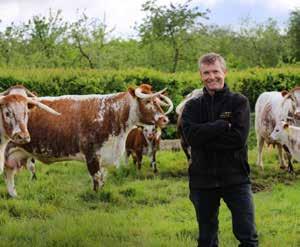

32
How the USA is falling back in love with English Longhorns
The English Longhorn is making a come back across the pond in the United States.


In 1975 at the age of 20 when I became secretary of the Society (as part of my training to become a Livestock Auctioneer with John Thornborrow & Co), it never remotely crossed my mind that one day I would be elected to the Society’s Council let alone the exulted, privileged and exciting position of chairman.
How the fortunes of the breed have changed in nearly 50 years, entirely down to you as progressive breeders. Whether you keep three or 300 cattle, it is all relevant and continues to produce a wide and broad spectrum of blood and family lines something that was particularly narrow in those early days.
While I would not wish you to think the chairman is an “old fuddy duddy” as progression is essential for any organisation, we should not dismiss history and always glance over our shoulders to learn from not only mistakes of the past, but actions that carried the breed forward – all things in life ebb and flow and as long as the “flowing over reaches the ebbing” we have a great opportunity to progress.
Why has the breed and the Society progressed from the doldrums of the pre 1970’s? Initially, and without question, the time and the effort John Brigg (Gorse) committed to keeping the Society “alive” in 1973 following the “Hill” Dispersal and, thereafter, the fantastic efforts subsequent chairmen, secretaries and Council members have devoted has formed a strong base.
The 1970’s were halcyon days for the beef industry as a whole, Continental breeds were being imported and there was a real buzz in the country for a progressive beef market. While Continental breeds may have overshadowed natives because of the general lift, everyone enjoyed an upward trend.
Dispersal sales including the Essex, Winthill, Grendon, Eyebrook herds to name but a few, attracted new buyers with ability, foresight, enthusiasm and most importantly professionalism in producing cattle to not only win prizes but to catch the eye of potential purchasers and new buyers.
Since the flowing decades of 1970’s and 1980’s the beef industry has hit some difficult times. Imports, BSE, FMD, TB, BTV and so on has meant all breeds have found the ebbing tide difficult to contend with.
However, in very recent years the beef trade has enjoyed a genuine uplift in demand (regardless of the tosh about animal emissions) and we as a Society must be poised to take advantage and portray the many attributes the breed possesses. My experience of cattlemen now when Longhorns are mentioned show an interest and don’t laugh as once was the case.
The advantages we have in this age compared to the 70’s,80’s and 90’s are much better publicity, marketing and social media skills all providing a great chance to preach the gospel. To do that the more good news stories we have from you as breeders is all grist to the mill.
Genomics is another breeding and management aid which, as time progresses, will I’m sure be relevant.
As a livestock man I have an ingrained love of all cattle pedigree or commercial, but having been secretary of the Society, official auctioneer for more than 40 years and stewarded Longhorns at the Royal Show for more than 25 years you can, I hope, tell I have a deep feeling and admiration for the Longhorn breed.
We have a great breed, so be proud, be committed and always produce your stock in the best possible form. You always get out what you put in!
Clive C Roads FLAA-Societychairman

THE
MEMBERS REPRESENT YOU:
Clive Roads, Worcestershire (Chairman) clive@mccartneys.co.uk 07702 722910
Bertie Facon, Oxfordshire bertrand.facon@gmail.com 07785 221961
Bernard Llewellyn MBE, Carmarthenshire bernard@carregcennencastle.com 01558 822291
Tom Mills, Derbyshire millso25@hotmail.com 07968 819134
Dave Phillips, Dorset dave.phillips@synergyfarmhealth.com 07500 626565
Pat Stanley, Staffordshire info@blackbrook-longhorns.com 07860 515893
Elise Sutton, Wiltshire elise.sutton@naturalengland.org.uk 07584 475779
Graham Walker, Yorkshire walkergraham93@gmail.com 07957 208021
Thea Woollatt, Monmouthshire theawoollatt@outlook.com 07836 611857
THE SOCIETY WOULD LIKE TO WELCOME
THE FOLLOWING NEW MEMBERS TO THE LONGHORN FAMILY:
Nick ap Simon, Oxfordshire
Chris Bailey, Lancashire
Dan Belcher, Leicestershire
Adam Buitelaar, Wales
Sam and Simon Burford, Derbyshire
Rob and Emma Burnett, West Yorkshire
Ed Chantler, Wales
Charlotte Clark, East Yorkshire
Ross Follett, Dorset
Kath Freeman, Leicestershire
Liz Gill, Norfolk
Richard Taylor, Gloucestershire
William Hamplett, Staffordshire
Victoria Holt, Norfolk
Brian Hunt, Lancashire
Michael and Heather Johnson, USA
M, V and A Keeble, Greater London
Hazel Laird, Fife
Amelia Lake and Chloe Bines, Cornwall
Sarah Lees, Lancashire
Nicholas and Justin Lockyer, Somerset
Rob Lunnon, Somerset
Andrew McConnell, Northern Ireland
Millichope Enterprises, Shropshire
Tim Piper, Kent
Angus and Nancy Stott, Wales
George Sturla, Wales
Susan’s Farm CIO, Cumbria
Tom and Katrina Trotter, Scotland
Elizabeth Vice, Derbyshir
Denise Vincent, Somerset
Dan Whittaker, East Yorkshire
Robin Wilson, Staffordshire
Alfred Woolley, Derbyshire

The Ambassador’s Award was launched in 2020 to recognise and reward a member promoting the Longhorn breed, whether it be in show classes not confined to Longhorn cattle, or by supplying cattle to exhibitions or events which advertise the breed, or those working hard in the promotion of Longhorn beef.
This award isn’t for the member who has won every trophy going in the show ring; it’s for the member who has promoted the breed in their own way – an unsung hero if you will. Council is open to all suggestions, so anything goes!
Members should contact the Secretary to nominate a member, or the member can nominate themselves. A few words and photos and hopefully website and social media links describing what this member has done recently to deserve being called a Longhorn Ambassador should be sent to the office by 13 September 2024.
All nominations will go to the Council meeting in September 2024 and a shortlist of three will be selected. The finalists and then the overall winner will be announced at the AGM in October 2024.
Nominees who are unsuccessful can be nominated again in future years and the Trustees will also consider unsuccessful nominees from previous years.
The Society would like to thank Bernard Llewellyn of the Carreg herd for providing a trophy for this award and Council are looking forward to seeing all the nominations that come in. The nomination form is on the website under ‘forms’, or members can contact Debbie in the office direct.
In March Tim Harding retired from Bollin Valley Partnership having worked there for 46 years.
Under Tim’s management, Bollin Valley have been great supporters of the Society, selling cattle at Society sales, showing at local shows and hosting Society visits. The herd is high health and type classifies so engagement with breed improvement has always been high on the list of priorities for Tim over the years.
A succession plan has been put in place so the herd will continue under the watchful eye of Naomi and Euan. Tim is determined to get to more Society social events now he has a little more time on his hands, however, as a breeder and judge of Derbyshire Gritstone sheep he’ll not be resting on his laurels! The Society wishes Tim a happy and busy retirement.


The Society was saddened to hear of the passing of Dilwyn Vaughan of the Carn Edward herd on Saturday 6 April. Dilwyn was an enthusiastic and committed supporter of the breed. He and Suzanne were always keen to join other members on Society visits to breeders both in the UK and abroad and was always quick with a quip and a joke. Dilwyn and Suzanne’s son Robert continues to breed Longhorns on the family farm in the Gwaun Valley, Pembrokeshire. The Society’s sincere condolences go to Suzanne and to Robert and Richard and their respective families.
Rocky Poulson, the husband of Society member Rita Poulson of the Ryehill herd, passed away on 17 September 2023. Rocky accompanied Rita to Society events when he could and was very much part of the Longhorn Cattle Society family. A thoughtful and professional farmer with a huge depth of knowledge, he will be missed by all who knew him.
Every couple of years the Society organises a photo competition for its members. In 2022 we repeated the highly successful format of posting the photos on the Society’s Facebook page and the number of likes determining the category winners. This was a huge success, so we’ll be doing the same this year.
Entries close on Monday 23 September 2024, so you’ve got all summer to get some fabulousphotostaken,allentrieswillpostedtoFacebooksoonafter.

The Society had a stand at the NBA Beef Expo on Saturday 27 April at North West Auctions, Jn36. The event is primarily aimed at commercial beef farmers, so the Society’s promotion focussed on the qualities of the Longhorn as a suckler cow to produce crossbred calves.
The stand had a purebred Longhorn steer and a Hereford sired steer out of a Longhorn cow kindly loaned by Jane Grant and Trish McDonnell of the Longbridge herd.
The categories are below and may be split of there are sufficient entries.
1. Posed animal (cow and calf count as one unit)haltered or free
2. Small herd (10 animals or less) in a landscape
3. Large herd (10+ animals) in a landscape
4. Longhorns at shows
5. Humorous: members and/or cattle
6. Longhorns in commercial setting e.g. pedigree bull with commercial cows, suckler cows, stores/prime stock
Rules
1. Closing date for entries is Monday 23 September 2024
2. No entry fee
3. All photographs must be taken by members of the Longhorn Cattle Society.
4. No photographs from professional photographers allowed.
5. No photographs that have been entered into any previous competition allowed.
6. It will be a condition of entry that photographs entered may be used by the Society for any purpose without fee.
7. Entries must be sent to the Secretary by the closing date giving full details of which class/es are being entered.
Entries can be sent to the Secretary by memory stick, email, FTP (such as Dropbox or WeTransfer) or WhatsApp. In each case each photograph must be identified with the members’ name and the class being entered. When you are sending photographs by email do check with the Secretary that she has received them if you don’t get an acknowledgement as sometimes big files don’t make it through the spam filter!




This year the photographer of the picture with the most overall likes will win a fabulous prize – a complementary half day on-farm photoshoot with Society photographers Country Girl Media*.
* within the UK
The weather was dry and bright which may have contributed to a smaller footfall than anticipated, but the stand attracted plenty of interest and we had some useful conversations with those farmers attending the event.



Why Longhorns for your farming business, what do they offer that other breeds don’t?
Their hardy nature. My farm is mostly sand and the cattle can stay out late into the winter to save on housing costs.
Where do you see Longhorns featuring in the beef industry in the next 15 years?
The popularity of the beef could hopefully lead to it featuring more on the supermarket premium schemes.
Horns - On or Off and why, depending on your answer.
On. I have no constructive reason as such, but as a pedigree breeder who likes to show as well, I prefer the look of the Longhorn with their horns as it maintains their true breed characteristic.
What role does performance recording and genomics have to play in the development of the breed? How can breeders best use modern breeding technologies, such as ET and AI to benefit the breed?
The breed and breeders will need to focus on performance recording and genomics in the future to maximise its potential. Just because it’s a traditional breed doesn’t mean it shouldn’t embrace technology and data capture to give evidence to the anecdotal performance. ET and AI can both accelerate and enhance such breeding programmes.
Is the breed gene pool over dominated by some bloodlines and, if so, what can be done about it?
I don’t think this is a problem anymore. We have tried to mix and match lots of different bloodlines since we started and our customers appreciate it.
Get to know Bertie
What are three things you couldn’t live without?
Good food, romance and English Longhorns
Name something many people wouldn’t know about you?
I’ll hopefully be British by September!
If you weren’t farming, what would you be doing?
Talking about farming
Favourite tipple?
Guinness

Is showing a help or hindrance in developing the commercial attributes of the breed?
Showing is first and foremost great fun and for some a welcome break away from the farm and has many social benefits. But it’s also a must-do for marketing purposes. The best of the breed is seen in the show ring and it’s the breed’s best shop window. It’s also good to compare your own cattle amongst others and see what other genetics are working in different herds.
Much is made of the eating quality of Longhorn beef, but the breed hasn’t achieved a tie-up with a major retailer when others have. Is this a positive or a negative?
I don’t believe in eating quality per se. I believe in managing, feeding, breeding, transporting and killing an animal properly and with respect, this can then be spoiled by bad cooking so all the elements have to be in place for the eating experience to be of a high level.
With beef prices on a high should breeders be culling harder to weed out poorer quality stock?
Yes. There is always a place for Longhorn beef – if members don’t want to finish cattle themselves then other members will be more than happy to. Members should play to their strengths, some are breeders, others are finishers.
This year’s show season is already gathering momentum for Longhorn breeders and first to hit the headlines, with not only a breed championship win, but a native interbreed title at Newark and Notts Show, for the 10-year-old cow Blackbrook Yelenah from John and Pat Stanley.
Judged by Josh Brigg, Yelenah is by Blackbrook Uruk-Hai and is out of the Blackbrook Moonraker daughter, Blackbrook Peach. Commenting on her championship win, Josh said: “She was an incredibly correct cow for her age with exceptional frame, udder, locomotion and presence.” She then went one better to take the interbreed native title later that day.
Next up in the show season with a breed championship win at the Smallholding and Countryside Festival at Builth Wells was Carreg Xia from Mr and Mrs B and M Llewellyn. This one is by Mayhill Statute and out of the Carreg King daughter, Carreg Nia.



The Society encourages its members to determine the health status of their cattle when offering cattle for sale, be it via private sales or public auction.
For official Society auction sales, all cattle forward must be TB tested, irrespective of their TB testing interval and the following health rules apply:
Vendors do not have to be in a health scheme. Individual testing of animals is perfectly acceptable, and can easily be done when the cattle are being TB tested.
Vendors not accredited via a health scheme wishing to blood test should do so not more than 60 days prior to the sale.
Vendors who are active members of a CHeCS approved health scheme and holding current health scheme accreditation are exempted from blood testing for the specified diseases. Members must apply to their Health Scheme provider for an animal health declaration card prior to the sale.
ThefollowingspecificrequirementsforSocietysalesare:
BVD:
CHeCS health scheme members:
Accredited and vaccinated (all cattle except calves at foot).
Vendors privately testing:
Negative blood test or ‘Tag & Test’ for Antigen and then vaccinated prior to sale. Calves at foot should either have a negative blood test for Antigen or been tag and tested negative for Antigen. There is no requirement to vaccinate calves at foot.
IBR:
CHeCS health scheme members
Accredited.
Vendors privately testing:
Negative blood test. When vaccinating a marker vaccine must be used. (Unless routinely vaccinating, vaccinations should be done post negative blood test)
Leptospirosis:
CHeCS health scheme members
Accredited.
Vendors privately testing:
Negative blood test.
Neospora
Testing recommended for all females.
Johnes:
CHeCS health scheme members:
There are no further requirements for vendors in risk level R1 or R2. Those that are in risk level R3, R4 or R5 require a negative blood test (all cattle except calves at foot).
Vendors privately testing:
These vendors require a negative blood test (all cattle except calves at foot) or faecal test if blood test timing is not compatible with TB test timing. Johne’s test sensitivities are poor and, therefore, membership of a health scheme is preferred but not mandated.
TB
In all cases vendors must test all animals more than 42 days old on the day of the sale for TB, irrespective of home testing interval.




E-mail: millso25@hotmail.com

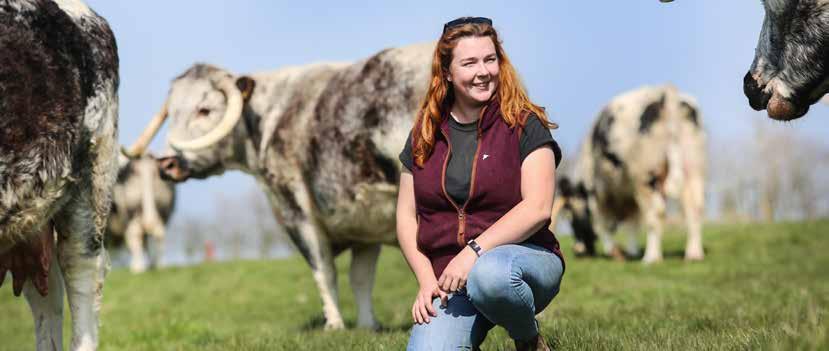
I was only elected as a trustee in October 2023, so I am serving my first term and feel I’m very much a newbie! I am also proud to be one of a handful of women who have been on Council and the youngest trustee to date!
do you hope to achieve by being a Council member?
When I was elected on to Council, one of the aspirations in my statement was to collect and collate baseline data for estimated breeding values for the Society to promote the breed. With an expansive collection of data to back up breed traits we can learn more about how the breed is performing compared to other breeds. This will only better the breed and Society when trying to market Longhorns in the dairy and commercial beef industries.
I also hope to encourage more young members to keep the breed and support their aspirations of owning a successful herd of Longhorns. There are already a number of talented young handlers and breeders that are doing so much for the breed, so it’s important to maximise that for the future.
If you could change or adapt one thing about the breed, what would it
Honestly, nothing! I think Longhorns have so much to offer as a breed. They are the ultimate suckler cow. That being said, I would like for the public perception of the breed to change and be valued more. When selling Longhorns through a market it can sometimes feel they are regarded as a “novelty breed”. The quality of the animal is at times overlooked by the presence of horns.
Many breeders have already demonstrated the versatility of Longhorns in commercial systems. From the use of bulls on dairy cows to the tremendous crosses with other native and Continental beef breeds. The breed has a lot to offer in terms of calf vigour, thriftiness and ease of calving. Not to mention their suitability to many farming systems and feed conversion ability which makes them appealing to those rearing the crossed calves. Maybe one day we will see Longhorn sired calves being offered premiums at abattoirs and in more supermarket schemes.
With farmers forced daily to look at reducing inputs and costs, where do you see the Longhorn fitting into the wider industry?
With the rise in regenerative farming practices and the Longhorn’s superior ability to finish on grass, I believe there is a bright future for the breed as more farmers look to reduce feed costs and finish from pastures alone. Combined with their docility, moving our suckler herd daily throughout winter using a paddock grazing method meant that the cows were quiet, maintaining condition and growing on a calf.
Longhorns have been a key part of the farm for 85 years. Robert Wales established the Stoke herd back in 1939 and we have continued his hard work breeding Longhorns. For me, the Longhorn is very much part of the landscape, the same as chalk is part of the farm’s soil. The years of breeding has hefted our herd to the fields where they thrive incredibly well off biodiverse, nutrient poor pastures. With careful breeding and selecting for traits that work for our farming business, we have produced functional fertile cows.
They are the ultimate cow that can convert nutrient poor forage into quality milk for their suckled calf or fatten for selling beef directly off farm. Selling beef direct off farm to customers has never been easier as the beef sells itself. Returning customers have always been astounded by the eating quality of the beef and I love being able to support our farming practices and the breed.
I think Longhorns and the breed Society offers a progressive future for the next generation of Longhorn breeders. There are so many breeders out there doing something different with their herd and it’s exciting to see all the different uses and systems the breed is thriving on. I hope we see more Longhorn beef being sold online and in shops, as well as seeing more Longhorns at agricultural shows going on to win native and interbreed championships to help market the breed to a wider beef cattle farming audience.
What can’t you live without?
My camera! You can always find me trying to get the best angles of the cows or chasing after a butterfly that won’t stop for a photo.
If you could invite six celebrities for dinner, who would they be?
David Attenborough, Ranulph Fiennes, Sebastian Vettel, Tom Cruise, Judi Dench and Emilia Clarke.
Name one thing many people wouldn’t know about you?
As a child I attended performing arts school for over 10 years. I have performed on multiple West End stages in musicals, competitions and operas.
If you weren’t farming, what would you be doing?
I would probably still be out in the field, but most likely doing some form of ecological surveying in the mountains of Scotland.
Top three songs of all time?
Silver Lining by Mt. Joy
In The Mood by Glen Miller Dog Days Are Over by Florence + The Machine


Simple, efficient cattle which thrive off lower input pastures are key to success for Steventon, Hampshire-based Matt and Sarah Horne’s Berrydown pedigree herd.

The couple’s 30-cow herd is managed alongside a 120-ewe commercial flock on an extensive permanent pasture-based system. “It is this available permanent pasture which makes the Longhorn the breed of choice for us. They thrive on lower input grass without needing supplementary concentrates,” explains Matt.
We don’t feed any concentrate to the cows, aiming for them to maintain condition on forage alone.
Founded in 2015, the herd started with a brace of heifers from the Barlings herd, Lincolnshire, with a bull, Fishwick Phoenix, added a year later from the Society’s sale at Worcester.
“ The same year we bought seven cows, three heifers and steer calves on the cows from the Yaverland herd on the Isle of Wight,” explains Matt.
“These were great cattle, with superb structure and breed character. They went back to either Cwrt Henllys or Saxonbury bloodlines and have left a great legacy in the herd which now has just five animals which aren’t homebred.”
Farming 260-acres on the Ashe Park Estate, Matt also works as a Watch Manager for Hampshire Fire Service. “Our background is in dairy, but we have done a number of other roles in agriculture too, working our way up to where we are now.”
Calving in January to March, the herd is housed in November when calves are weaned, with cows staying in and being fed solely on haylage over the winter months. “We don’t feed any concentrates to the cows, aiming for them to maintain condition on forage alone.
Cows have access to rock salt and we use a pour on fly treatment and wormer.
“We do, however, offer a creep blend to calves should grass struggle over the summer. This just takes a little bit of pressure off the cows and means the calves are easier to handle when we need to do anything with them,” he says.
To help maximise growth from grass the couple are gradually improving some pastures by reseeding with herbal leys and clover leys. “We’re not organic,


but farm in a largely organic manner due to farming at the source of the river Test,” adds Sarah.
With the herd in the Premium Cattle Health Scheme, it is BVD and IBR Accredited and is Johne’s level two. “We don’t vaccinate for anything, trying to manage disease risk through monitoring and proactive management.
“Cows always have access to rock salt and we use a pour on fly treatment and wormer, with youngstock also receiving a mineral bolus.”
On the breeding front, Matt says for the first year the couple used Fishwick Lord of the Rings as an AI sire, prior to purchasing Fishwick Phoenix. “Both of these did a great job for us.



“We then retained a homebred bull out of a Barlings cow, Berrydown Rufus. We continued to AI the two Barlings cows as they were related to Rufus.
“Following that we’ve been using Gupworthy Virocity, a bull we bought privately after he was breed champion at Royal Bath and West. He was a great bull with great fertility, getting every cow in calf in a seven-week window.” Bulls are generally changed every three years or so to bring new genetics through the herd.
And while the couple respect the character that horns add to the breed, they believe disbudding calves destined for slaughter is a key management tool for them. “One or other of us is often working
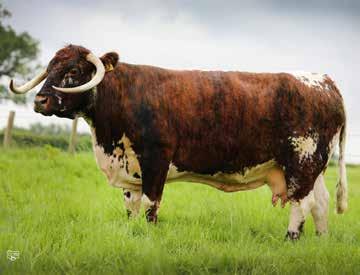
with the cattle alone, so having horns is just another risk factor that we can avoid by disbudding.
“On top of that we often sell a good number as stores and it makes them much more appealing to finishers if they’re disbudded. For us it’s about maximising the market opportunity, but we fully understand that for many it is the horns that give the breed its character and make them visually appealing.”
Aside from selling stores, the couple also finish a handful of cattle each year, selling them as boxed beef. “We enjoy doing the beef boxes and the feedback we get from customers, but there is a bit of hassle associated with it, so we don’t do too many,” says Sarah.
We enjoy doing the beef boxes and the feedback from the customers is always very favourable.
As part of their herd and breed promotion, Matt and Sarah do try and show when time allows, favouring local, one-day shows as these fit their workload better than longer shows. “We have done bigger shows before, but they take a lot more planning than the one-day shows and mean more time away.
“The likes of Gillingham and Shaftesbury and Alresford are some of the local shows we try and support each year, with the aim of growing breeding stock sales as we start to have more stock available,” adds Sarah. “However our best win is probably taking reserve champion at Bath and West with a homebred female, against some good competition!”

 By Pat Stanley
By Pat Stanley
From the earliest records of British agriculture there has been a race of cattle set apart from other breeds by their distinctive horns.
The Longhorn, as they became known, were predominant in medieval times over a large area of the Midland counties and Northern England. Their origin is shrouded in mystery, but the Craven district of Yorkshire, northern Lancashire, Cumberland, Westmorland, Staffordshire, Derbyshire and Leicestershire hold the honour of being greatly linked to this grand old breed.
The Midlands must, however, be given full credit for the improvement that was affected in the Longhorn, and certainly held the reputation as the stronghold of the breed. Here it was to be transformed from a multi- tasking role of milk, meat and draught animal to one whose primary function was beef.
It was improved and designated as our first British beef breed by that great high priest of livestock breeding, Robert Bakewell (1725-1795). It was Bakewell’s aim to feed the masses who had left the rural areas and moved into towns and cities in pursuit of work during the Industrial Revolution.
Bakewell gave us the blueprint for all livestock improvement and one that is still followed to this day. Bakewell brought his herd to great perfection and worldwide repute, so much so that for many years after his death they were still referred to as the Dishley, or New Leicester breed. His stock was used to improve many other regional types/breeds.
In the early days of the breed, cheese and butter making was the main occupation of farmers and in this capacity the Longhorn at that point had no equal. It is said that Stilton Cheese was first produced at Wymondham, in the Melton Mowbray district of Leicestershire using the superior, rich, quality milk of the Longhorn.
The Longhorn is a particularly hardy breed, with a robust constitution and will thrive well in most situations. Of a medium frame, they have great length, well sprung ribs and wide level backs. The hide which should be mellow to the touch, is well
and thickly covered with silky hair. Through the winter their hair becomes thick and rough, to enable them with little or no shelter to withstand the season and emerge in the spring still looking fit.
In past times they earned the nickname of the ‘Leicestershire Curly Coat’. These are just some of the many reasons the Longhorn is wonderfully adapted to produce product in a most sustainable and environmentally friendly way, as well as in a variety of systems.
Longhorn cattle have a quiet temperament which makes them an ideal beef animal, not prone to stress, ensuring that meat quality is of the highest specification. Used for crossing purposes the Longhorn is extremely successful, passing on its many attributes including wealth of flesh of the best sort, hardiness, ability to convert forage and good mothering ability.
They make an excellent cross for dairy cattle due to ease of calving and vigorous offspring. Cross bred Longhorn calves are currently commanding a premium from the dairy sector in an exciting new era for the breed.
It is gratifying that artisan butchers are now using Longhorn as their premium product, bringing the breed full circle and placing them back on the pedestal on which Robert Bakewell first placed them. Its many excellent attributes will serve it well, to compete in new and emerging markets across the globe providing meat of exemplary texture and flavour to a more discerning marketplace.




Topping trade for Longhorn cattle at the Society Spring Show and Sale at Worcester in April, as well as setting a new breed record for a Longhorn senior heifer were Ben and Tori Stanley of the Melbourne, Derbyshire-based Melbourne Park herd.
Sale leader was Melbourne Park Kiggle, a March 2022born daughter of the former Midlands Club Bull of the Year, Southfield Nuke EX94. Out of a homebred female by Blackbrook Trapper, Kiggle stood second in the senior heifer class in the pre-sale show. After spirited bidding this heifer finally knocked down at 6000gns to Ben and Jennifer Sutton, Monmouth, for their Whitehouse herd.
Joint second highest price on the day was a call of 5000gns for Coalville, Leicestershire-based John and Pat Stanley. Blackbrook Godiva is by Blackbrook Darth Vadar EX92 and out of a homebred female by Blackbrook Acer EX90. She found a new home with David Blockley for the Southfield herd, Bradford, West Yorkshire.
Also selling for 5000gns and leading trade for bulls on the day was the pre-sale champion, Longbridge Warren from Jane Grant and Trish McDonnell, York, North Yorkshire. The pick of judge Wendy Finucane, Carmarthenshire, Warren is by Gorse Yukon, a son of the breed record holder and 12,000gns Gorse Rosa EX92. Securing this one was AHarriet Butler, Tamworth, Staffordshire.
Back with females and Ben and Tori Stanley were back in action selling their first prize senior heifer, Melbourne Park Kate, a daughter of the 2022 Great Yorkshire Show champion and Bull of Year, Herbertsherd Issac out of another homebred daughter, Melbourne Park Heart Stealer, a former Female of the Year. She was knocked down to Jane Grant and Trish McDonnell for the Longbridge herd.
Next up and selling for 4000gns was Carreg Warrior from B and M Llewellyn, Llandeilo, Dyfed. Born February 2022, this Fishwick Lord of The Rings EX93 son is out of the successful show female, Carreg Romance EX90, a Fishwick Macavity daughter. Securing this one were the Goodman Bros, Witley, Worcestershire.
Joining the previous one with the Goodman Bros at 3000gns was the reserve champion, Gentons Wentworth from Bertie Facon, Banbury, Oxfordshire. This January 2022-born son of Gentons Ramses EX93 is out of the Fishwick Macavity daughter, Fishwick Paulina EX92.









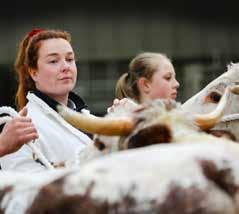
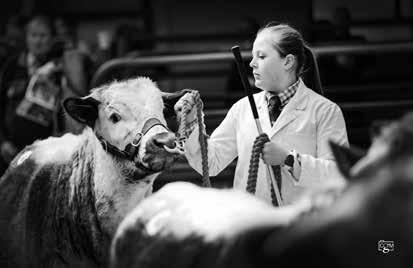





The Society is grateful to the Governor and staff of HMP Kirkham for inviting the Society to visit the Kirklan herd for their summer visit later this year on 27th July. The day is a joint visit between the Society and the Northern Longhorn Breeders’ Group.
The Kirklan herd was established in 1991 with purchases of Linton and Longrove breeding. The herd was substantially added to in 2007 when the Newbrook herd at HMP Hewell Grange was dispersed and over the years further breeding has been added to the herd, with Southfield, Blackbrook, Fishwick and Oxlane among some of the well-known prefixes in the herd today.
In 2006 Keith Burrell and Peter Barton arrived at HMP Kirkham with five Longhorns following the closure of the dairy farm at HMP Lancaster Farms. They have built up the herd over the last 25 years and when they arrived most of the land was put over to horticulture with no fencing or infrastructure necessary for livestock.
Over this time Keith and Peter have built utility buildings to house the cattle, put in irrigation, water troughs and fencing and created more than 60 acres of grassland, producing their own silage year on year. The management team at Kirkham were fully supportive of the farm and livestock enterprise and continue to recognise its value as real work experience opportunity for prisoners and a great asset to the prison and prison visitors to see.
Keith and Peter have created a prize-winning herd of Longhorns and the prison has a solid reputation throughout the Society which is down to the life’s work and dedication of them both. Staff are proud of their herd and visitors to the prison are always amazed at what they have achieved within the prison. The herd now totals some 60 head, with three current stock bulls; Aberdeen Quartz, Stoke Mudlark and the homebred bull Kirklan Victory.
For many years the herd was a regular fixture at Society shows, particularly the Royal Show. HMP Kirkham is a Category D (open) prison and prisoners were able to attend the show with the cattle, giving them valuable experiences in readiness for release at the end of their sentences. Unfortunately, budget
constraints have meant that the Kirklan prefix has not been seen in the show ring for a few years now.
Grassland is managed to benefit wildlife where possible, incorporating uncut field margins and hedging. Some awkward corners have been fenced off and planted with grouped hazel, while wildlife corridors have been incorporated between fields and single trees and hedging have been planted where possible. There are also three bee hives producing honey which is down to Peter who is the bee expert. There is always more to do having a site of more than 200 acres which includes the prison accommodation, staff workspaces, industries, woodland, ponds, arable, greenhouses, polytunnels and gardens. Rare breed Large Black pigs and Hebridean sheep are also kept complementing the cattle enterprise.
For more information and to book your place on the summer visit, see the ‘events’ page of the website. Due to the nature of the location, no visitors under 18 years of age are permitted.

The Royal Three Counties Show is hosting the Society’s National Show this year and the Society will have a stand at the show in the Breed Society Row near the cattle lines.
The Society would like to extend a warm welcome to all members who would like to join the Society for a light lunch and a prize giving after judging on Friday 14 June.
The Show has been awarded both the Burke Beef and Burke Dairy trophies. Those members who remember the Royal Show will know that this is one of the most prestigious interbreed awards to win, given to a male/ female pair chosen by the relevant breed society from the cattle forward at the show. The Longhorns last won the beef Burke at the Royal Show in 1981 with Eyebrook Richard and Rousham Carnation.
I have had a fantastic lifetime working, judging and showing cattle and sheep.
The cattle story includes taking many championships with all manner of breeds including Friesians, commercial cattle, Limousins, Longhorns, British Whites, Gloucesters, Highlands and Beef Shorthorns, throughout the UK.
It all started with an after school and weekend job on a local farm in 1972. The year I left school, in 1975, I was asked to prepare and show a commercial crossbred at Northampton Fatstock Show, which I won. I was heavily involved in the Northants Stockmans Club where I had my first judging experience of British Friesian heifers at the age of 16.
After attending agricultural college I worked for the MLC at their bull performance testing centre at the Royal Showground, Stoneleigh, which consisted largely of native breeds and later, Limousins. This increased my passion for pedigree beef breeding.
I then went to work as stockman for a Limousin herd and had great success in the show and sale rings and was invited to judge numerous shows as well as the herd competition.
Over the years I’ve had the pleasure of judging other breed herd competitions, including Longhorns and Beef Shorthorns.


In 1984, in France, I judged a show of Limousins but first had to learn how to lead their team of oxen!
My Longhorn knowledge really cemented when I moved to the Toddington herd in the early 90’s, with numerous rare and native breeds on the farm, we had great success with Longhorn cattle. I later moved to Croxton Park, Cambridgeshire in 1994, and ran Beef Shorthorns.
Plenty of judging opportunities have come my way for different breeds and interbreed competitions, all throughout the UK, Europe and North America. During this time, I became President of the Beef Shorthorn Cattle Society and had a stint as a Trustee at The RBST.
It is a great honour to be invited to judge the National Longhorn Show this year, as it is 12 years since I last judged this competition, both at the Three Counties Show. I hope it will not be as wet as last time!
The Society AGM will be on Saturday 5 October, with a weekend of visits on both Saturday 5th and Sunday 6th October. We will be based in the historic town of Droitwich, Worcestershire and our Saturday visit will be to the Witley herd, by kind invitation of Andrew and Ruth Goodman.
The family are well known for their ‘Goodmans Geese’ enterprise, rearing more than 10,000 Christmas geese and turkeys for private and wholesale customers.
Andrew sells his purebred Longhorn store cattle through Worcester Market with regular buyers always keen to secure his cattle. To read more about the farm, see the April 2022 edition of ‘The Longhorn’ magazine.
There will be a tour of the farm to see the large Longhorn herd and the young geese and turkeys. The lunch and AGM will also be held at the farm, making it convenient for everyone attending.
After the AGM there may be the opportunity to visit Great Witley Church, known as ‘Britain’s Finest Baroque Church’, which is near the farm.
Our Sunday visit will be to the Withybed herd of Longhorns belonging to Adrian Bytom and his son Oliver at Coopers Hill Farm, Alvechurch, Worcestershire.
The farm runs to a little more than 100 acres of permanent pasture which is grazed by the Longhorn herd on a rotational basis, as well as being made into hay for winter fodder. An area of the farm adjacent to the Worcester and Birmingham Canal was redeveloped a few years ago to build a marina for narrow boats which

has proved highly successful. Adrian and Olly finish their Longhorns and sell them through a small ‘pop up’ shop on the farm, marketing them through word of mouth and social media. There is also a kiln dried log business, a number of small enterprises in converted farm buildings and a glamping/wedding site. Recent improvements to the cattle enterprise have included a bespoke handling system bought with a grant from DEFRA Farm Equipment and Technology Fund.
In addition to the activities on the farm, Adrian runs a company that provides Longhorns to graze nature sites for the Worcestershire Wildlife Trust and the National Trust. The cattle move onto these sites in the summer and are brought off again in the winter.
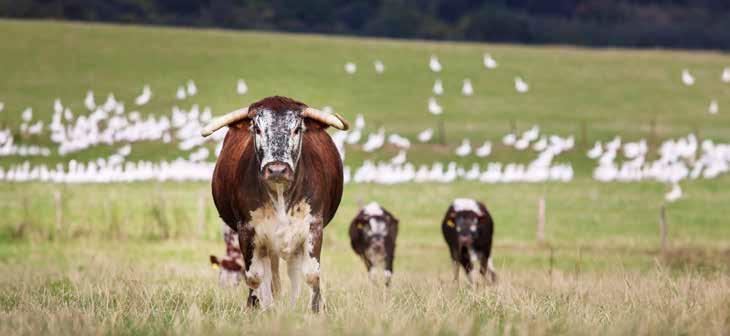

A family history steeped in traditional Somerset cider making meant that when David Sheppy wanted to add some cattle to his business it had to be a native breed.

For over 200 years the Sheppy family have been making cider, and for the last 100 years at Three Bridges Farm between Taunton and Wellington in the heart of Somerset. Society member and Master of Cider David Sheppy is the sixth generation of his family to make cider, and the Longhorns are an important part of the business.
“I always wanted to run a native breed alongside the cider business here on the farm and Longhorns are the perfect fit.
Female replacements are homebred, with new stock bulls sourced every three years or so.
“They are docile and easy to handle and thanks to their eye-catching looks are a firm favourite with visitors to our farm shop, café and restaurant,” he explains.
Founding the herd on females from the Tripps, Gorse and Stoke herds, David grew numbers up
to 25 cows plus followers, but has since reduced numbers due to time pressures.
“The cider business and retail aspects of that have grown considerably in recent years and I simply didn’t have time to manage a larger herd as well as I wanted to. So, we cut back. But I continue to enjoy the challenge of cattle breeding and all that comes with it,” he says.
Nowadays, female replacements are homebred, with new stock bulls sourced every three years or so.
“We generally run two stock bulls at a time, replacing one when he starts to come back on his daughters.
“At the moment we’re using Slough Okeydokey and Gupworthy Spinach, with the former being 10 years old, but probably in as good a shape as he’s ever been,” explains David who farms with his wife, Louisa.
Entirely spring calving, the Three Bridges herd grazes about 60 acres of permanent pasture along with 15 acres of traditional orchards on the 300-acre farm, with a further 75 acres of modern orchards and 150 acres let.
“Again, we used to farm it all ourselves, but we’ve scaled back on the arable side, renting all that ground out now and concentrating on the cider apples, with the Longhorns using the pasture ground.
“We aim to run the herd on a commercial basis, with all bull calves dehorned at three to four months old and most cattle finished on-farm at 24-26 months old and 550-600kg,” says David.



“We retain a few heifers each year, and sell a few breeding heifers with everything else either finished for use in the farm shop and restaurant or sold through the live ring at Sedgemoor Market.
“Disbudding the bullocks means buyers aren’t put off them and we generally get a good trade for anything we put through the ring. Most years we sell 8-10 finished cattle through the shop and restaurant, having them slaughtered locally and cut and vacuum packed.
“We have fridges in the shop which we stock with the beef and run special Longhorn steak nights in the restaurant.
“Previously, we had a butchers counter in the shop too, but the expense of having to employ two fulltime butchers made that unviable,” he explains.
Longhorn cows are such great natural fleshers that we don’t need to feed them anything other than grass and silage
A previous devotee of the show ring, time limits the chances of the Three Bridges herd making an appearance these days, but David is still an avid studier of the genetics within the breed. “We used to put a lot of time into showing and attending Society sales and I got a great deal of enjoyment from it. Hopefully, in time I’ll be able to get back to it.”

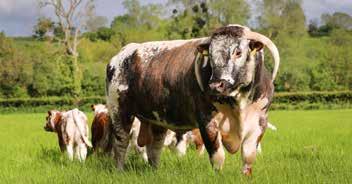
Cattle management is based around high health status, with the herd being vaccinated for both Leptospirosis and BVD and monitored for both IBR and Johne’s.
“Knowing we’re on top of these diseases is a great peace of mind and we vaccinate for clostridial diseases too.
“Aside from that, herd management is kept simple, with housed cows only receiving silage and hay and finishing cattle fed a blend to put a little extra cover on them. Longhorn cows are great natural fleshers that don’t need to be supplemented with anything other than the grass and silage they eat,” he adds.


A near 50-year association with the Longhorn breed and a career spent in pedigree and commercial livestock marketing has given incoming council chairman Clive Roads an unrivalled insight into the breed and its potential.
“My first connection with the breed came when I was training with livestock auctioneer John Thornborrow and Co. After Bill Noakes’ death John Brigg took on running the Society, but by 1975 it had become too big a concern for John to continue with and he asked John Thornborrow if any of his staff would be able to take it on.
“He nominated me to do it as part of my training and that’s how I first became involved in the breed.”
Clive remained as Society secretary until 1984 when he moved from Leamington Spa-based John Thornborrow and Co to McCartneys where he has remained ever since, now acting as a consultant, having relinquished his partnership in the firm in recent years.
“Longhorns have always been part of my career and I was fortunate enough to have the honour of stewarding the breed classes for 25 years at the Royal Show and have judged them at various shows across the UK too.
“I appreciate there may be some breeders who will wonder how a man who has never bred Longhorns has become chairman of council. However, I hope my independence, combined with my knowledge of both the breed and the livestock industry allows me to bring an objectivity to the role,” he explains.
Clive says there can be no doubt the breed is in as strong a place today as it ever has been thanks to the dedication of breeders. “Anyone who knows anything about cattle can see how much the quality within the Longhorn breed has improved over time.
“Not that there weren’t good cattle previously, but there perhaps weren’t so many good cattle as there are now. What the breed has now is real strength and depth across a great many herds.

“That has come as breed enthusiasts have been joined by more professional cattle breeders who have brought with them knowledge and skills which have helped develop the breed.”
Importantly, he says, that breed development has been done from within the breed without external genetic influences and has meant the breed has lost none of its unique character and essential traits as a result.
“Longhorns still look and behave like Longhorns always have, but in the last 15-20 years the standard of cattle has improved markedly, and it can be seen at shows and sales every year.
“The development of the Longhorn really shows what can be achieved in a breed when people produce what the market wants. The use of modern technologies, such as embryo transfer to expand female families has, of course, helped, but having the right cattle in the first place is essential,” highlights Clive.
Now, with increasing opportunities in both the dairy and suckler sector, he believes breeders may have some tough choices to make. “The growth of the Buitelaar scheme, allied with demand from the suckler sector for easy calving bulls for use on heifers is great to see.
“However, these buyers aren’t, understandably, so keen on buying bulls with horns. They create a health and safety issue in large herds and also potential welfare issues,” he believes.
“While leaving horns on the breed undoubtedly gives the breed its unique character and means a herd of Longhorns is instantly recognisable, it does also create challenges. There is a case to be made for dehorning a greater proportion of animals in
herds and particularly bulls which are going to be sold for commercial use.
“For any breed to truly succeed it needs to have a solid commercial customer base and we need to pay attention to what those customers are looking for. The horns of a Longhorn really are a ‘catch 22’ situation for a lot of breeders.”
Clive believes the breed has a great future in the commercial beef sector, with its maternal traits marking it an excellent breed for use in producing suckler replacements. “We must recognise that while the breed is renowned for its high-quality beef, it is never going to challenge the established terminal sire breeds.
“Its place is as a maternal breed, either purebred or crossbred, being put to another beef breed to maximise productivity.”
And while there have been some attempts at introducing polling into the breed in the past which have been acknowledged by the Society, Clive says for this to happen it will require outside genetics to be used. “There are no polled genetics within the breed, so they’d have to be introduced from outside. This may not be seen as hugely beneficial if it meant compromising other traits within the breed.”
Looking ahead he feels the breed can achieve more and there is scope for breeders to enjoy higher prices, provided they produce the right cattle, with current beef prices dictating a bottom in the market.
“It’s got to be a bad beast now that doesn’t get in to four figures in the store ring and Longhorns and Longhorn crosses have been selling well at recent sales at Worcester, so breeders should take note of this when selecting animals to retain or sell for breeding.
“If you’re in any doubt then it’s probably better sold as a store or finished for beef. The trade is there and should act as a solid incentive when making these decisions.”
He urges breeders to look carefully too when it comes to buying stock. “With store and finished prices where they are, there is no justification for not
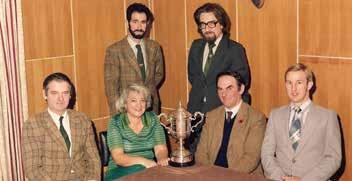


investing in quality breeding stock. It doesn’t take many store cattle to buy a good bull nowadays and ultimately, good breeding stock are an investment not a cost. You only get out what you put in, so a little more investment, allied with a little more effort in management can soon reap huge rewards.”
Away from his work with McCartneys Clive says he is not much of a one for holidays, preferring to spend his free time enjoying the countryside and countryside sports.
“I’m also a council member of the Three Counties Agricultural Society and former show chairman of Royal Three Counties Show, as well as having been lucky enough to judge both sheep and cattle at shows across the UK.
“I do tend to take a few days in France every few years as I’ve always had a fascination with the D Day Landings, so I enjoy taking time to visit some of the landing sites and learn a little more every time I go.
“I can’t say when or how this fascination started as none of my family served in the armed forces due to being in reserved occupations.”
He also says he finds his working life far more relaxed since relinquishing his partnership, largely due to the surge in livestock prices in recent years. “I still sell the store cattle every Saturday at Worcester and when you see some of the bills at the end of the day it can be frightening. But that’s not my concern anymore, I can leave the hassle of bad debts to someone else!”
English Longhorns were once a common sight in the United States. These powerful beasts with their majestic horns provided food and draft power for the early settlers as they traveled across the frontier. Though the breed is now nearly extinct in the US, these historic bovines are an irreplaceable link to the past.
For several years these animals were privately owned and unavailable for purchase. That changed when the November-December 1999 issue of The American Livestock Breeds Conservancy newsletter contained a small advertisement reading: “Old English Longhorns: The only ones in America. One bull, two females. All breeding age. Available Fall 1999.”
The cattle ended up on a farm in Virginia. It is unclear what other genetics were later introduced, but we do know there was minimal genetic diversity and most of the country’s breeding stock over the next decade descended from those original four animals.
Conner Prairie, located in Indiana in the Midwestern United States, is a museum with a strong agricultural program focusing on heritage breeds. Intrigued by their uniqueness and desiring to raise something different from the Devons and Shorthorns typically found at living history museums, Kevyn Miller, then serving as Conner Prairie’s livestock manager, decided to research Longhorns.
Owning English Longhorns would serve two purposes at Conner Prairie – to educate the public about a
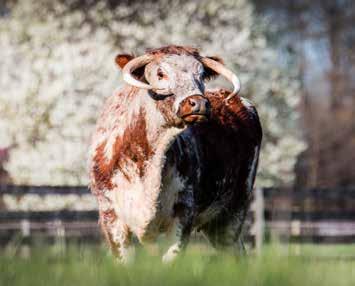
critically endangered breed that was a part of our nation’s agricultural history and to further our efforts in promoting heritage breeds. We initially borrowed a cow and a heifer calf from the Virginia herd, then turned our attention to finding new genetics. Import bans created difficulties, but with the generous help of John and Pat Stanley of Blackbrook Longhorns, we were able to import semen. ln 2012, our first heifer calf was born.
In 2014, the agricultural staff decided to increase our preservation efforts, purchasing four young steers to be trained as oxen and leasing a few heifers from the Virginia herd. We also imported more semen from another bull, enabling us to breed daughters from the original bull.
The breakthrough came when the import ban was lifted and we had the opportunity to import embryos and purchased embryos from two different matings.
In March of 2017 our first embryo transfer calf was born. Unrelated to anything in the United States, this bull, christened CP Roundabout, secured his place as our future herd sire for many years, offering fresh genetics for a breed with a tight pedigree. The national
response to this calf’s birth was overwhelming, with news outlets from across the country reporting the story. Though the popularity of this calf was unexpected, the media attention it garnered brought more attention to the breed and cultivated more awareness about heritage breeds as a whole.
Since that initial birth we have had several more embryo transfer calves born. These unrelated pedigrees offer a renewed chance of survival for the breed. Roundabout sired numerous calves, both through natural service and via AI, extending the Longhorns’ reach across the country. Our success with the embryo transfer work meant that we needed to import another round of genetics, this time with the added help of Gentons Longhorns. These bulls will allow us to breed several generations and continue to build the country’s genetic pool.
Current livestock manager Emily Nyman wanted to take the project a step further and began the work of finding out what animals in our herd could be officially registered with the Longhorn Cattle Society. After extensive communication, DNA testing and sorting through pedigrees, she was able to get all but two of our herd formally registered.
Our goals for this breed are simple. To keep the breed alive and viable, find the niche that makes them marketable and sell them to breeders who want to preserve and promote them. Our efforts currently focus on increasing numbers and setting up satellite herds across the country both to help establish other breeders and to preserve our genetic line in case disease or natural disaster would destroy our small herd.
Although it has been a long time coming, we are now in a position where we can start using Longhorns for meat, collaborating with local chefs who are interested in working with the breed’s unique qualities. Offering dinners featuring heritage breeds and food sales at special events, we are beginning the process of providing the public with the opportunity to experience one facet of what makes this breed so special.
We have sold breeding stock to other farms, who have found value both in purebred stock as well as crossing their Longhorn bulls with other cows to create high quality beef. We have collected and sold semen from our bulls and are exploring the possibility of collecting embryos as well. As a public
institution, our cattle are on display for hundreds of thousands of guests to see every year and their unique appearances inspire curiosity about what makes these cattle so special. It is vital that we create a demand for the breed so that it becomes sustainable and profitable for other farms to raise, ensuring survival for the future.
It may seem odd that a museum in the United States would invest so much time, money, and effort into saving a breed like the English Longhorn, but we believe that the breed has significant intrinsic value. Primarily, we believe it is vital to keep the legacy of Robert Bakewell’s work alive. Furthermore, Longhorns have a significant place in our nation’s history as records of great white-backed cows with “rag horns” exist dating back as early as 1627. By 1836, the year portrayed in Conner Prairie’s fictional village of Prairietown, English Longhorns were very common, so they add an element of realism and historical accuracy to our experience areas. Beyond their connection to the past, however, English Longhorns may play an important role in the future of agriculture. The grass-friendly attributes, easy calving traits and their docile temperaments make them perfect in small farm, homestead, and museum settings. Though there are fewer than 60 of these magnificent animals currently in America, the breed is gradually making a return. Although Kevyn Miller sadly passed away in 2018 and was unable to witness the growth of his beloved breed in the United States, he laid the foundation to begin restoring these cattle. Through the efforts of breeders in the US, the Longhorn Cattle Society and breeders around the world, this irreplaceable breed will be preserved for generations to come, and Conner Prairie is honored to be at the forefront of their survival in the United States.

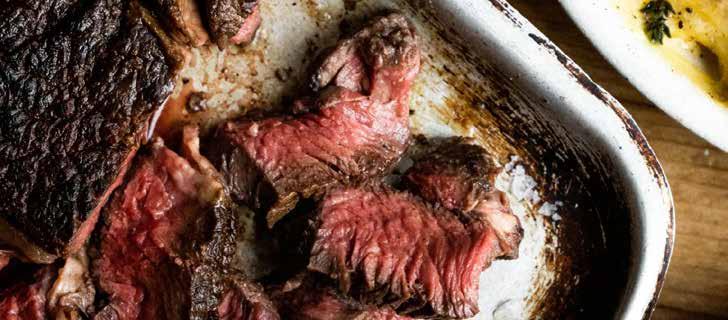
As the saying goes, ‘Cooking is like love: It should be entered into with abandon or not at all.’ What’s better than showing someone you love them by cooking a thoughtful, delicious meal? This is the recipe you need up your sleeve when Valentine’s Day rolls around.
Credit pipersfarm.com
CÔTE DE BŒUF
h 1 Côte De Bœuf
h Olive oil
h 50g salted grass fed butter
h 2 garlic cloves, bashed
h 1 small bunch of Thyme
DAUPHINOISE POTATOES
h 200ml double cream
h 2 garlic cloves, grated
h 1 tablespoon Finely chopped Thyme
h 1/4 bulb of nutmeg, grated
h 375g waxy potatoes, peeled & finely sliced
h Grass fed butter, for greasing
h Sea salt
h Freshly ground black pepper
1. Preheat the oven to 180C. Remove the Côte De Bœuf from the fridge an hour before you plan on cooking it to bring it up to room temperature. Season well with salt and pepper.
2. To make the dauphinoise, warm the cream in a small saucepan with the garlic, thyme and nutmeg. Season this cream really well with salt and pepper. It’s important to get it almost over seasoned, as it will have the job of seasoning the potatoes as well. Place the poateos in a bowl, pour over the cream and mix thoroughly.
3. Grease a small baking dish with butter. Layer up the potatoes in the dish until it’s full. Place a sheet of baking parchment over the surface and bake for 25 minutes. Remove the baking parchment and return the dish to the oven for a further 15 minutes until the top of the dauphinoise takes on some colour.
4. Heat a wide, heavy-based frying pan until hot. Add a drizzle of oil to the outside of the Côte De Bœuf and place in the pan, fat side down. Use a pair of tongs to hold the piece of beef in place and carefully render down the fat, creating a lovely golden crust on the beef fat.
5. Remove the beef from the pan and pour away any excess fat. Increase the heat of the pan until very hot, then add the beef, cut side down, and fiercely sear the meat for 2 minutes on each side.
6. Once again remove the beef from the pan and leave to cool a little. Now add the butter, bashed garlic and sprigs of thyme to create an aromatic butter. Return the beef to the pan and continue to cook on each side. It is useful as this stage to have a digital thermometer probe to keep track of how the beef is cooking. For rare, aim for a core temperature of 48-52C; for medium aim for 55-58C and 60C for well done. If you don’t have a temperature probe, cooking the beef in the butter for a further 4 minutes on each side should work well.
7. Transfer the beef to a tray, pour over the butter and leave to rest for 10 minutes. Carve into thick slices and serve with the rich dauphinoise potatoes and sharp watercress salad.
Recipe by Gill Meller
A bowl of noodles and a well-spiced broth is heavenly in the colder months and a real warming treat after a long windswept winter walk. This super tasty Spiced Beef Broth with Chilli, Sesame, Ginger, Tamari and Noodles by Gill Meller really hits the spot and is filled with goodness.
The full flavour of the beef broth is packed full of natural vitamins and minerals that will give your body the winter boost it needs.
h 1kg Shin of beef on the bone
h 2 carrots scrubbed and split
h 1 onion quartered
h 2 bay Leaves
h 4 garlic cloves, bashed
h 2 stems lemon grass, bashed
h 2 thumb-sized pieces ginger, sliced
h 1 red chilli, roughly chopped
h 1 tablespoon Sunflower oil
TO FINISH THE BROTH
h 3-4 Spring onions, trimmed and thinly sliced
h 2 tablespoons sesame seeds toasted
h 2 tablespoons rice wine vinegar
h 3-4 tablespoons tamari
h 2 tablespoons
h Toasted sesame oil
h 1 medium bunch coriander
h 2 nests medium egg noodles
1. Heat a large heavy based casserole pan over a high heat. Add the oil and when it’s hot add the pieces of beef shin. Fry the beef for 4 to 5 minutes on each side so it takes on a lovely dark caramelised colour.
2. Now add the rest of the base ingredients to the pan. Give everything a stir, pour over 1.5 litres of water or enough to cover all the ingredients, and bring the pan up to a simmer. Turn the heat down, cover with a lid and let the beef cook very gently for 3 hours.
3. When the beef is lovely and tender take the pan off the heat and use a slotted spoon to lift the beef out onto a plate. Pour the cooking liquid through a fine sieve into a clean bowl or jug.
4. While the beef is cooling, skim the excess fat off the top of the broth, then add the broth back to the pan. Set the pan back over the heat and bring it up to a simmer. Pull the beef shin into small shards and pieces, discarding any tougher membrane or pieces of fat.
5. When the soup is simmering, add the noodles to the pan then after a minute or so, the beef along with the rice wine vinegar, tamari, sesame oil, spring onions and toasted sesame seeds Cook for a further minute or two then take the pan off the heat. Roughly chop the coriander and stir this through.
6. Check the seasoning. You can adjust the balance with a splash of more vinegar or tamari sauce.
7. Ladle the broth into a bowl and serve, with extra chilli if you like and a spritz of lime juice.








Bertie Facon
M: 07785 22 1961
Ben Bellew M: 07710 054792
E: gentons.longhorns@gmail.com
Lessor Farm, Milcombe, Banbury, OX154RT
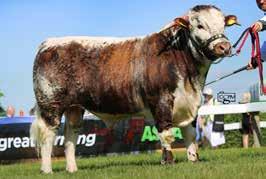



14-16th June 2024
National Show
Royal Three Counties Show, Malvern,Worcestershire.
The Society’s flagship showing event, see the best of the best in the show ring
9-12th July
Great Yorkshire Show
Harrogate, North Yorkshire.
A great turnout of Longhorns is guaranteed
23-25th July
Royal Welsh Show
Llanelwedd, Builth Wells, Powys.
The must-do event for all Welsh Society members
27th July
Society summer visit HMP Kirkham, Nr Preston, Lancashire.
A unique opportunity to visit the Kirklan herd ‘behind bars’
5-7th October
AGM weekend, Worcestershire.
The perfect excuse for a weekend away! The chance to relax, meet up with other members, have your say at the AGM and visit some interesting herds.
